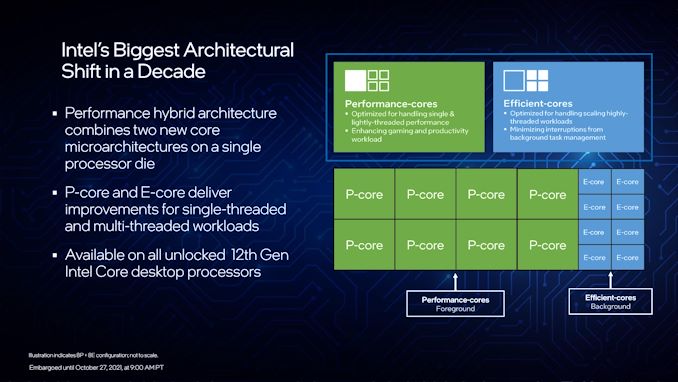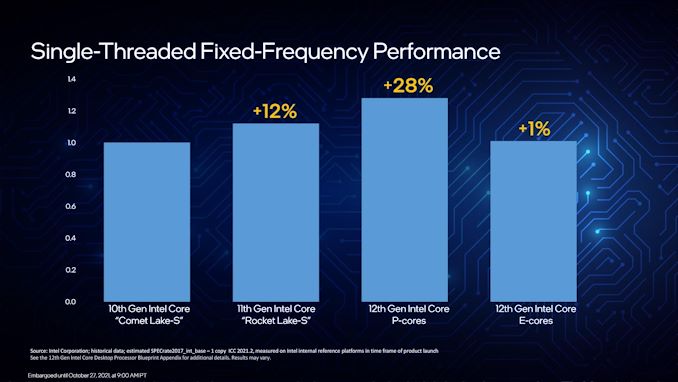Intel 12th Gen Core Alder Lake for Desktops: Top SKUs Only, Coming November 4th
by Dr. Ian Cutress on October 27, 2021 12:00 PM EST- Posted in
- CPUs
- Intel
- DDR4
- DDR5
- PCIe 5.0
- Alder Lake
- Intel 7
- 12th Gen Core
- Z690
A Hybrid/Heterogeneous Design
Developing a processor with two different types of core is not a new concept – there are billions of smartphones that have exactly that inside them, running Android or iOS, as well as IoT and embedded systems. We’ve also seen it on Windows, cropping up on Qualcomm’s Windows on Snapdragon mobile notebooks, as well as Intel’s previous Lakefield design. Lakefield was the first x86 hybrid design in that context, and Alder Lake is the more mass-market realization of that plan.
A processor with two different types of core disrupts the typical view of how we might assume a computer works. At the basic level, it has been taught that a modern machine is consistent – every CPU has the same performance, processes the same data at the same rate, has the same latency to memory, the same latency to each other, and everything is equal. This is a straightforward homogenous design that’s very easy to write software for.
Once we start considering that not every core has the same latency to memory, moving up to a situation where there are different aspects of a chip that do different things at different speeds and efficiencies, now we move into a heterogeneous design scenario. In this instance, it becomes more complex to understand what resources are available, and how to use them in the best light. Obviously, it makes sense to make it all transparent to the user.
With Intel’s Alder Lake, we have two types of cores: high performance/P-cores, built on the Golden Cove microarchitecture, and high efficiency/E-cores, built on the Gracemont microarchitecture. Each of these cores are designed for different optimization points – P-cores have a super-wide performance window and go for peak performance, while E-cores focus on saving power at half the frequency, or lower, where the P-core might be inefficient.
This means that if there is a background task waiting on data, or something that isn’t latency-sensitive, it can work on the E-cores in the background and save power. When a user needs speed and power, the system can load up the P-cores with work so it can finish the fastest. Alternatively, if a workload is more throughput sensitive than latency-sensitive, it can be split across both P-cores and E-cores for peak throughput.
For performance, Intel lists a single P-core as ~19% better than a core in Rocket Lake 11th Gen, while a single E-core can offer better performance than a Comet Lake 10th Gen core. Efficiency is similarly aimed to be competitive, with Intel saying a Core i9-12900K with all 16C/24T running at a fixed 65 W will equal its previous generation Core i9-11900K 8C/16T flagship at 250 W. A lot of that will be that having more cores at a lower frequency is more efficient than a few cores at peak frequency (as we see in GPUs), however an effective 4x performance per watt improvement requires deeper investigation in our review.
As a result, the P-cores and E-cores look very different. A deeper explanation can be found in our Alder Lake microarchitecture deep dive, but the E-cores end up being much smaller, such that four of them are roughly in the same area as a single P-core. This creates an interesting dynamic, as Intel highlighted back at its Architecture Day: A single P-core provides the best latency-sensitive performance, but a group of E-cores would beat a P-core in performance per watt, arguably at the same performance level.
However, one big question in all of this is how these workloads end up on the right cores in the first place? Enter Thread Director (more on the next page).
A Word on L1, L2, and L3 Cache
Users with an astute eye will notice that Intel’s diagrams relating to core counts and cache amounts are representations, and some of the numbers on a deeper inspection need some explanation.
For the cores, the processor design is physically split into 10 segments.
A segment contains either a P-core or a set of four E-cores, due to their relative size and functionality. Each P-core has 1.25 MiB of private L2 cache, which a group of four E-cores has 2 MiB of shared L2 cache.
This is backed by a large shared L3 cache, totaling 30 MiB. Intel’s diagram shows that there are 10 LLC segments which should mean 3.0 MiB each, right? However, moving from Core i9 to Core i7, we only lose one segment (one group of four E-cores), so how come 5.0 MiB is lost from the total L3? Looking at the processor tables makes less sense.
Please note that the following is conjecture; we're awaiting confirmation from Intel that this is indeed the case.
It’s because there are more than 10 LLC slices – there’s actually 12 of them, and they’re each 2.5 MiB. It’s likely that either each group of E-cores has two slices each, or there are extra ring stops for more cache.
Each of the P-cores has a 2.5 MiB slice of L3 cache, with eight cores making 20 MiB of the total. This leaves 10 MiB between two groups of four E-cores, suggesting that either each group has 5.0 MiB of L3 cache split into two 2.5 MiB slices, or there are two extra LLC slices on Intel’s interconnect.
| Alder Lake Cache | |||||||
| AnandTech | Cores P+E/T |
L2 Cache |
L3 Cache |
IGP | Base W |
Turbo W |
Price $1ku |
| i9-12900K | 8+8/24 | 8x1.25 2x2.00 |
30 | 770 | 125 | 241 | $589 |
| i9-12900KF | 8+8/24 | 8x1.25 2x2.00 |
30 | - | 125 | 241 | $564 |
| i7-12700K | 8+4/20 | 8x1.25 1x2.00 |
25 | 770 | 125 | 190 | $409 |
| i7-12700KF | 8+4/20 | 8x1.25 1x2.00 |
25 | - | 125 | 190 | $384 |
| i5-12600K | 6+4/20 | 6x1.25 1x2.00 |
20 | 770 | 125 | 150 | $289 |
| i5-12600KF | 6+4/20 | 6.125 1x200 |
20 | - | 125 | 150 | $264 |
This is important because moving from Core i9 to Core i7, we lose 4xE-cores, but also lose 5.0 MiB of L3 cache, making 25 MiB as listed in the table. Then from Core i7 to Core i5, two P-cores are lost, totaling another 5.0 MiB of L3 cache, going down to 20 MiB. So while Intel’s diagram shows 10 distinct core/LLC segments, there are actually 12. I suspect that if both sets of E-cores are disabled, so we end up with a processor with eight P-cores, 20 MiB of L3 cache will be shown.













395 Comments
View All Comments
shabby - Wednesday, October 27, 2021 - link
Typo in the 12600 charts... 20 threads or 16?nandnandnand - Wednesday, October 27, 2021 - link
16 threads.2p + e = 2*6 + 4
Thread count typos are going to happen a lot with Alder Lake, Raptor Lake...
at_clucks - Friday, October 29, 2021 - link
20-30 years ago it was really easy to know everything important about a CPU (frequency more or less, maybe multiplier/FSB) just by looking at the model name. Intel made it really confusing for the past few generations even for the relatively mundane setup with multi-identical-cores at a certain frequency. Now with the different types of cores, different base and turbo frequencies, different thread count, etc. you'll have to search for the table every time.And we're in the easy part now, just high end, all models ending in "00". Can't wait for the "12672KSF" which has random tweaks here and there depending on what they could get out of the wafer.
yeeeeman - Friday, October 29, 2021 - link
Neah, if you went to school at least you can count.Hifihedgehog - Wednesday, October 27, 2021 - link
AMDead… until Zen 4. Zen 3+ is dead to me, because Zen 3+ is a band-aid solution to hobble along until they can get Zen 4 is out the door. Packing on a cache block is not going to beat this. Only a fresh and fast microarchitectural update can regain performance for AMD. And that update is Zen 4.Hifihedgehog - Wednesday, October 27, 2021 - link
Also, timing is crucial and hitting the moving target. Zen 4 may beat Alder Lake but can it beat Raptor Lake which will likely come out late next year? If not, AMDead will be dead even with Zen 4, even if Zen 4 is a huge improvement over Zen 3. AMD has to compete against Intel’s best at time of release, not against itself.schujj07 - Wednesday, October 27, 2021 - link
Yes because we have independent benchmarks out already from real world usage and not Geekbench. Don't forget to look at the power usage on the new Intel CPUs. They very well could be faster than AMD, however, if they need double the power to be 15% faster that really isn't a win.shabby - Wednesday, October 27, 2021 - link
Don't think intel cares about losing the efficiency crown on the desktop, they just want to be at the top of the charts at all costs. Now in the server department with dozens of cores then it starts to bite them in the ass.Hifihedgehog - Wednesday, October 27, 2021 - link
Most desktop users could care less about power efficiency. If this were a laptop or notebook question, that would be a totally different story. That is an interesting point you bring up, though! It's likely why Intel released desktop BEFORE mobile. Historically, they release first to mobile and then desktop. Power efficiency may be very well why they opted to avoid pushing it to mobile first. Or not at all. They may just be trying to counter AMD where it hurts most, in their current Ryzen stronghold.schujj07 - Wednesday, October 27, 2021 - link
Power efficiency does make a slight difference on the desktop. If you need use a huge AIO or air cooler compared to a mid range air cooler that hurts your pocket book. That can also make your system louder than the comparable other system. Not to mention it will affect your summertime electric bill if it keeps heating up the room so your AC is kicking on.